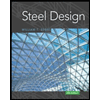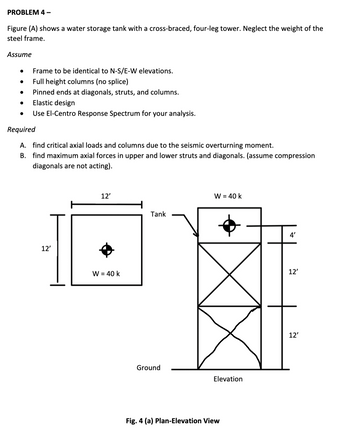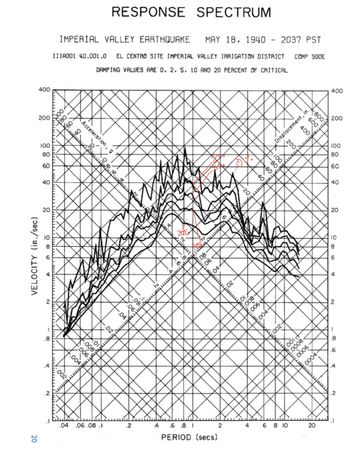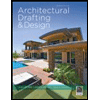
Steel Design (Activate Learning with these NEW titles from Engineering!)
6th Edition
ISBN: 9781337094740
Author: Segui, William T.
Publisher: Cengage Learning
expand_more
expand_more
format_list_bulleted
Question
Use the second picture to answer the question, Thank you so much for your help!

Transcribed Image Text:PROBLEM 4-
Figure (A) shows a water storage tank with a cross-braced, four-leg tower. Neglect the weight of the
steel frame.
Assume
• Frame to be identical to N-S/E-W elevations.
•
Full height columns (no splice)
•
Pinned ends at diagonals, struts, and columns.
•
Elastic design
•
Use El-Centro Response Spectrum for your analysis.
Required
A. find critical axial loads and columns due to the seismic overturning moment.
B. find maximum axial forces in upper and lower struts and diagonals. (assume compression
diagonals are not acting).
24
12'
12'
W = 40 k
W = 40 k
Tank
Ground
Elevation
Fig. 4 (a) Plan-Elevation View
4'
12'
12'

Transcribed Image Text:RESPONSE SPECTRUM
IMPERIAL VALLEY EARTHQUAKE
MAY 18, 1940 - 2037 PST
IIIA001 40.001.0 EL CENTRO SITE IMPERIAL VALLEY IRRIGATION DISTRICT COMP SOOE
DAMPING VALUES ARE O. 2. 5. 10 AND 20 PERCENT OF CRITICAL
400
200
F80
Acceleration, g
80
60
40
8884
100
20
20
086
4
VELOCITY (in./sec)
.8
201
02
800
006
004
002
الله
2
86
Displacement, in.
-20
400
008-
600
400
200
60
200
100
80
60
-800
40
20
20
006
004+
10
986
F2000
4
2
0013
8000
0006
0004
.8
.6
2
4
6810
PERIOD (secs)
.1
.04 .06.08.1
.2
4 .6.81
20
4
2
20
20
Expert Solution
This question has been solved!
Explore an expertly crafted, step-by-step solution for a thorough understanding of key concepts.
Step by stepSolved in 2 steps

Knowledge Booster
Similar questions
- A W1422 acts compositely with a 4-inch-thick floor slab whose effective width b is 90 inches. The beams are spaced at 7 feet 6 inches, and the span length is 30 feet. The superimposed loads are as follows: construction load = 20 psf, partition load = 10 psf, weight of ceiling and light fixtures = 5 psf, and live load = 60 psf, A992 steel is used, and fc=4 ksi. Determine whether the flexural strength is adequate. a. Use LRFD. b. Use ASD.arrow_forwardUse the composite beam tables and select a W-shape and stud anchors for the following conditions: Span length = 18 6 Beam spacing = 9 ft Total slab thickness = 51 2 in. (the slab and deck combination weighs 57 psf). Lightweight concrete with a unit weight of 115 pcf is used Construction load = 20 psf Partition load = 20 psf Live load = 225 psf Fy=50 ksi and fc=4 ksi A cross section of the formed steel deck is shown in Figure P9.8-9. The maximum live-load deflection cannot exceed L/360 (use a lower-bound moment of inertia). a. Use LRFD. b. User ASD.arrow_forwardDetermine the smallest value of yield stress Fy, for which a W-, M-, or S-shape from Part 1 of the Manual will become slender. To which shapes does this value apply? What conclusion can you draw from your answer?arrow_forward
- A column in a building is subjected to the following load effects: 9 kips compression from dead load 5 kips compression from roof live load 6 kips compression from snow 7 kips compression from 3 inches of rain accumulated on the roof 8 kips compression from wind a. If lead and resistance factor design is used, determine the factored load (required strength) to be used in the design of the column. Which AISC load combination controls? b. What is the required design strength of the Column? c. What is the required nominal strength of the column for a resistance factor of 0.90? d. If allowable strength design is used, determine the required load capacity (required strength) to be used in the design of the column. Which AISC load combination controls? e. What is the required nominal strength of the column for a safety factor of 1.67?arrow_forwardA beam must be designed to the following specifications: Span length = 35 ft Beam spacing = 10 ft 2-in. deck with 3 in. of lightweight concrete fill (wc=115 pcf) for a total depth of t=5 in. Total weight of deck and slab = 51 psf Construction load = 20 psf Partition load = 20 psf Miscellaneous dead load = 10 psf Live load = 80 psf Fy=50 ksi, fc=4 ksi Assume continuous lateral support and use LRFD. a. Design a noncomposite beam. Compute the total deflection (there is no limit to be checked). b. Design a composite beam and specify the size and number of stud anchors required. Assume one stud at each beam location. Compute the maximum total deflection as follows: 1. Use the transformed section. 2. Use the lower-bound moment of inertia.arrow_forwardNote For Problems 9.6-1 through 9.6-5, use the lower-bound moment of inertia for deflection of the composite section. Compute this as illustrated in Example 9.7. 9.6-3 For the beam of Problem 9.3-1, a. Compute the deflections that occur before and after the concrete has cured. b. If the live-load deflection exceeds L360 , select another steel shape using either LRFD or ASD.arrow_forward
- Compute the nominal shear strength of an M1211.8 of A572 Grade 65 steel.arrow_forwardEstimate the transverse tensile strength of the concrete in Problem 12.6.arrow_forwardIf the beam in Problem 5.5-9 i5 braced at A, B, and C, compute for the unbr Cb aced length AC (same as Cb for unbraced length CB). Do not include the beam weight in the loading. a. Use the unfactored service loads. b. Use factored loads.arrow_forward
- A plate girder must be designed for the conditions shown in Figure P10.7-4. The given loads are factored, and the uniformly distributed load includes a conservative estimate of the girder weight. Lateral support is provided at the ands and at the load points. Use LRFD for that following: a. Select the, flange and web dimensions so that intermediate stiffeners will he required. Use Fy=50 ksi and a total depth of 50 inches. Bearing stiffeners will be used at the ends and at the load points, but do not proportion them. b. Determine the locations of the intermediate stiffeners, but do not proportion them.arrow_forwardCompute the nominal shear strength of an M107.5 of A572 Grad 65 steel.arrow_forward
arrow_back_ios
arrow_forward_ios
Recommended textbooks for you
 Steel Design (Activate Learning with these NEW ti...Civil EngineeringISBN:9781337094740Author:Segui, William T.Publisher:Cengage Learning
Steel Design (Activate Learning with these NEW ti...Civil EngineeringISBN:9781337094740Author:Segui, William T.Publisher:Cengage Learning Architectural Drafting and Design (MindTap Course...Civil EngineeringISBN:9781285165738Author:Alan Jefferis, David A. Madsen, David P. MadsenPublisher:Cengage Learning
Architectural Drafting and Design (MindTap Course...Civil EngineeringISBN:9781285165738Author:Alan Jefferis, David A. Madsen, David P. MadsenPublisher:Cengage Learning Materials Science And Engineering PropertiesCivil EngineeringISBN:9781111988609Author:Charles GilmorePublisher:Cengage Learning
Materials Science And Engineering PropertiesCivil EngineeringISBN:9781111988609Author:Charles GilmorePublisher:Cengage Learning Engineering Fundamentals: An Introduction to Engi...Civil EngineeringISBN:9781305084766Author:Saeed MoaveniPublisher:Cengage Learning
Engineering Fundamentals: An Introduction to Engi...Civil EngineeringISBN:9781305084766Author:Saeed MoaveniPublisher:Cengage Learning Construction Materials, Methods and Techniques (M...Civil EngineeringISBN:9781305086272Author:William P. Spence, Eva KultermannPublisher:Cengage Learning
Construction Materials, Methods and Techniques (M...Civil EngineeringISBN:9781305086272Author:William P. Spence, Eva KultermannPublisher:Cengage Learning

Steel Design (Activate Learning with these NEW ti...
Civil Engineering
ISBN:9781337094740
Author:Segui, William T.
Publisher:Cengage Learning

Architectural Drafting and Design (MindTap Course...
Civil Engineering
ISBN:9781285165738
Author:Alan Jefferis, David A. Madsen, David P. Madsen
Publisher:Cengage Learning

Materials Science And Engineering Properties
Civil Engineering
ISBN:9781111988609
Author:Charles Gilmore
Publisher:Cengage Learning

Engineering Fundamentals: An Introduction to Engi...
Civil Engineering
ISBN:9781305084766
Author:Saeed Moaveni
Publisher:Cengage Learning

Construction Materials, Methods and Techniques (M...
Civil Engineering
ISBN:9781305086272
Author:William P. Spence, Eva Kultermann
Publisher:Cengage Learning